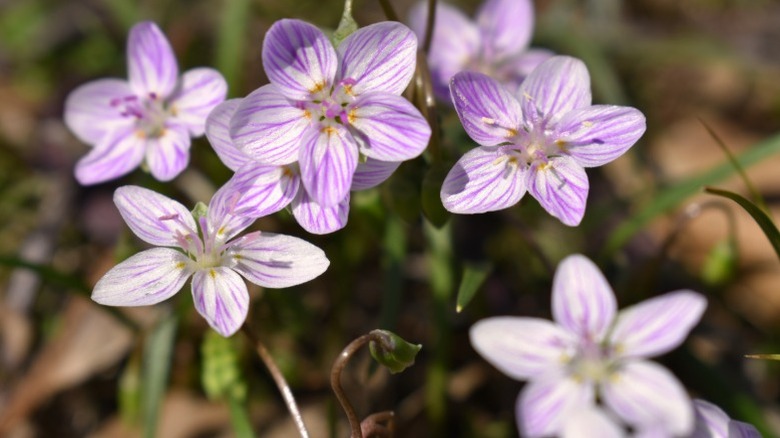The Native Edible Plant That Produces Gorgeous Spring Flowers
You don't have to limit your edible plants to the vegetable garden. There is a vast cornucopia of plants that pair beauty with edible parts that make great additions to your outdoor landscaping. If you want to hop on the newest gardening trend and grow edimentals, consider the delightfully named fairy spud (Claytonia virginica). Fairy spud, also known as spring beauty and ground nut, is a native perennial that is safe for human consumption. It is related to purslane, although it has a more moderate growth rate compared to common purslane (Portulaca oleracea), another edible plant. It is native to the central and eastern U.S. and has historically served as a source of sustenance for Native Americans and early settlers.
This herbaceous perennial, which dies back after flowering in spring, is hardy in zones 3 to 8. Thriving in moist, but well-drained, soil, fairy spud prefers rich, slightly acidic sites in partial shade but will tolerate poorer ground. Popularly used for groundcover, fairy spud spreads low to the ground, without getting much taller than 6 to 12 inches. If you look at this plant at nighttime or during very cloudy conditions, you might see closed, nodding flower heads. Thankfully, they perk back up when they're back in the light.
Benefits of growing fairy spud in your garden
The delicate blooms of the fairy spud are striking at first glance. Growing in clusters, the flowers feature five petals with pink lines on them. The petals themselves are white to light pink in color, accompanied by pink anthers to match. Fairy spud blooms in early spring, from mid April to early May, appearing quickly after popping out of the ground. It's an ideal flowering perennial to plant for a stunning spring, but the name spring beauty comes from its fleeting appearance. By June, this plant typically is done blooming and is dormant until the next spring season.
All parts of the fairy spud plant are edible. This species grows from edible corms, which have a taste that's dependent on whether they are cooked or not. Raw fairy spud corms are reminiscent of radishes, while cooked corms have a similar taste to boiled chestnuts. However, before you dine on the fairy spud in your yard, take note of our expert's tips to ensure that the edible flowers in your garden are safe to eat, especially making sure never to treat them with harmful pesticides. But even if you don't want to eat fairy spud corms or flowers, growing it in your yard is a way to provide a native food source for pollinators, small rodents, and white-tailed deer.

